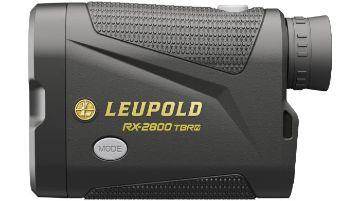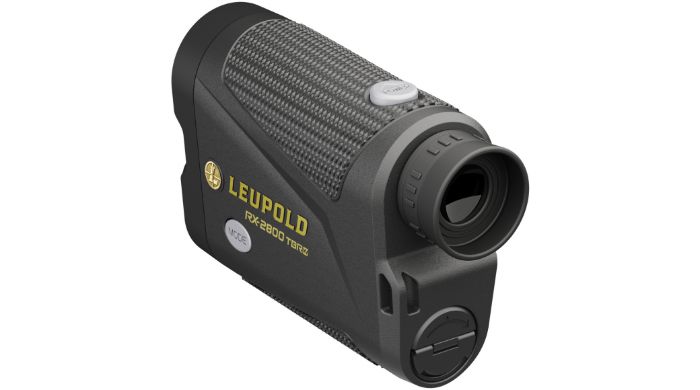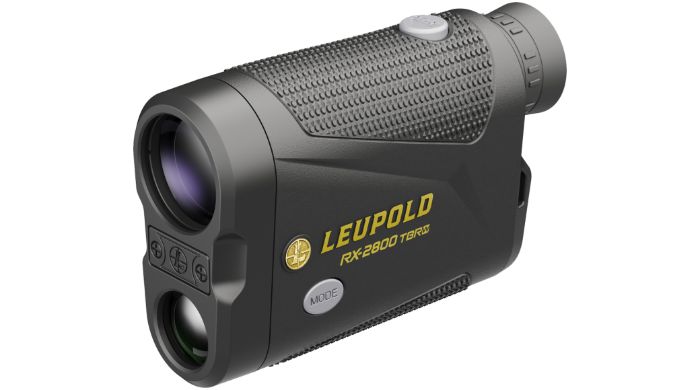If you want to push the limits, the RX 2800 can get you to distance and beyond more accurately than inferior rangefinders.
With pre-loaded ballistic groups, wind compensation, and on-board MIL and MOA adjustment values, the Leupold unit has a lot to offer.
It’s why it’s a favorite long-range target shooting rangefinder, and it may prove worthy on your big sheep hunt or competition meet.
Quick Overview...
What We Like: Feature-packed Leupold
What We Don’t Like: No adjustable wind & atmospheric data
Best Uses: Hunting, Bow Hunting, Target Shooting, Competition Shooting, Ballistic Data
- Yard Range: 6-2800
- Magnification: 7x
- Objective Lens: 27mm
- Display Type: LED
- Dimensions: 4.3 x 1.5 x 3”/7.9 oz
- Waterproof/Fogproof: Yes/Yes
- Angle Compensation: Yes

Our Verdict: The RX 2800 TBR/W is a high-end rangefinder with a lot of potential. Suitable for all shooting applications, tough as nails, and accurate as can be for a 2800-yard unit, it’s one of the best rangefinders available today.
Who is the Leupold RX-2800 TBR/W Best Suited to?
A unit like the RX 2800 is best suited to all types of hunters and shooters, especially competition shooters. Its long-range performance and pre-loaded ballistic data allow for on-board adjustments and wind compensation.
While its most attractive features are its TBR with Wind and ballistic program, it still holds a lot of value to shooters who are using their own solvers. But you may as well have the tech even if you only need it for comps than be without it when it’s needed.
How Does the Leupold RX-2800 TBR/W Perform?
When the RX-2800 first came out, it was the next best thing since sliced bread in the rangefinder world. However, between then and now, we’ve seen longer ranging, Kestrel connecting, and tighter beam divergence units hit the market. Is the RX unit still worth it?
There is no doubt that it’s worth its price point as a tech-packed rangefinder under $500. Its primary advantage is the TBR/W ballistics and wind compensation program. While very advanced, it’s not Bluetooth compatible, and it’s designed to provide you with more than what you need without the costs and complexity of adding more “unessential” technology.
Another noteworthy feature is its tripod mounting ability. It’s a 7x unit that is not unlike many of the best hunting rangefinders in the market, but you’d be surprised with how many cannot be tripod mounted.
With last target mode, angle inclination readouts, waterproof housing, and a class 3R laser, the RX-2800 TBR/W is a promising unit for the long-range target shooter and hunter.
Features & Benefits

Feature-Packed Leupold
While Leupold provides no specifics about its glass, many are happy with the clear, sharp glassing experience and have even used it as a backup bino with its 7x power.
The OLED display is impressive in itself. It has adjustable brightness settings and little to no illumination bleeding. It’s sharp, easy to read, and highly visible even during low-light conditions when it’s dialed down.
You can toggle modes on and off, select various reticles, and measure in either yards or meters. The display also allows for decimal readings for extra precision.
What may not be big deal to you, but is certainly worth some thought, is all the button pressing you’ll be doing. With the Mode button on the side, there is no accidental confusion between using the right controls, but either more buttons or a type of navigation wheel would be convenient for complex menus like this one.
The Maven RF.1, although a lot less feature-packed but has longer ranging, has a navigation wheel that should be a trend that manufacturers may want to pick up on.
Alpha IQ
The Alpha IQ is what powers the ranging engine and provides less than one-second scan returns, and target acquisition up to 1100 yards on deer and 1300 yards on trees. These are the tested and provided values by Leupold although the extended 1800 and 2400-yard ranges on deer and trees is often touted by the brand.
The DNA technology in the unit provides accuracy of 0.5-yards out to 125 yards and +/-2-yard accuracy at maximum distances.
Another interesting note is that the RX has a Class 3R laser instead of the Class 1 we’re accustomed to seeing. Not a huge point of interest as greater concern should be focused on the sensor quality, beam divergence, and overall performance.
TBR/W
TBR/W stands for True Ballistic Range/Wind and is effective out to 800 yards. You may get more than what you initially thought with the RX unit as the TBR/W function offers four modes: BAS, MIL, MOA, and TRIG.
BAS is probably what you will use for hunting as it provides the equivalent horizontal distance with angle, ballistics, and sight-in distance taken into account.
MIL and MOA modes provides both the LOS distance and the mils or MOA needed to adjust. This includes ballistics and sight-in distance calculations.
Lastly, the TRIG mode is excellent for competition shooters, professional long-range target shooters, etc. who need to know both true horizontal and true vertical ranges alongside the inclination/decline. Obviously, trigonometric algorithms are involved, and it may be more information and clutter on the screen for the traditional hunter, but the capability is there when you need it.
The RX rangefinder is preloaded with several pages of ballistic load groups and up to 10 mph perpendicular crosswind estimations accurate to 1.5 MOA at 600 yards. If you’re especially knowledgeable, you can adjust the hold values for drift and direction. Think along the lines of ½ value at 1 o’clock, ¾ value at 2 o’clock, full value at 3 o’clock, ¾ value at 4 o’clock, and ½ value at 5 o’clock, etc. angles.

Last Target Mode
It pays to be transparent with your buyers from the get-go about the types of codes “hardwired” into the rangefinder. Specifically speaking, it pays to let the buyer know if they’re getting first or second target modes. In this case, the Leupold RX unit functions in Last (second) target mode.
This means that it will provide readings on the furthest target within the field of view. We also suspect that it takes cluster readings into account, and with a 1.172 mrad beam divergence, it’s essential to know that you’re getting the reading on the target and not the far hill behind it.
Selectable Reticles
Leupold was smart to incorporate selectable reticles in their long-ranging unit. The tricky part is making sure that the reticles align with the laser beam for full confidence in positive return scans on the intended target. With what we know about its beam divergence and actual field performance, it has no alignment issues.
There are three reticles to choose from: Plus Point, Duplex with Plus Point, and Duplex without Plus Point. The Plus Point is a small cross-style reticle with a see-through center dot. It’s best suited for ranging small targets like varmints or when you need to get extended range and desire a seemingly tighter reticle to get on point.
The Duplex with Plus Point is exactly what it says it is; easy to use, fast to get focused, and it doesn’t obscure the target at the center. Duplex without Plus Point retains the familiar duplex reticle with an open and clear center.
Limitations

No Adjustable Wind & Atmospheric Data
The unit is preloaded to adjust for wind at 10 mph speeds at 90-degree angles to the muzzle when wind compensation is activated. There is no way to adjust for various angles or wind drift. You will need to rely on how to adjust your own values based on the current conditions.
On that same note, there are no atmospheric values provided nor with the pre-loaded ballistic load groups.
So, while it does cater for some environmental factors, it doesn’t do everything. Obviously, if you use your own ballistic programs and use the RX 2800 solely as a rangefinder for distance, it still offers value.
Popular Questions
Unfortunately, the Leupold RX-2800 TBR/W is not covered under Leupold’s lifetime warranty. The rangefinder is limited to a 2-year warranty that starts from the date of purchase.
Golf rangefinders should have a first target mode that picks up on close targets such as the pin. With the RX 2800 operating in second target mode, it will pick up the targets behind the pin.
Scan mode may help to find the pin, but the Leupold RX 2800 TBR/W is best suited for hunting and shooting applications.
No. The RX does not have Bluetooth and is not compatible with ballistic load transfers between devices. The unit has preloaded ballistic load groups that you will need to select and use for accurate ballistic adjustment values.
The RX 2800 is made in China under Leupold’s specs and quality control requirements.
Conclusion
Those are the quick ins and outs of the RX 2800 TBR/W rangefinder. You’ll want to keep the manual close as it takes quite the amount of menu navigating and willingness to learn all the TBR modes. If you can’t find your load listed in the provided charts, there are ways to figure it out – and it will take some figuring out.
As you can see, it’s a very detailed and feature-packed unit. While it can be used without taking full advantage of all its features, it would be a shame to cut its potential short.
To maximize both your shooting potential and your gear potential, get on board with the Leupold RX.
Further Reading




